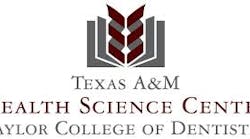Texas A&M University Baylor College of Dentistry receives $5.4 million for predoctoral and postdoctoral programs
Texas A&M University Baylor College of Dentistry (TAMBCD) has received $5.4 million in funding from the Health Resources and Services Administration (HRSA) of the US Department of Health and Human Services to expand its predoctoral and postdoctoral training, helping to bridge the gap that currently exists between medicine and dentistry. More than 5 million Texans live in dentally underserved areas, according to 2014 numbers from the Health Resources and Services Administration. Of those individuals, more than 1.5 million did not receive dental services the same year. What makes those figures even more staggering is that the needs of these vulnerable, underserved populations are not limited to dental care. Where oral health is lacking, there also may be unmet medical or psychosocial needs.
___________________________________
RELATED
Enough talk about the oral-systemic link: It's time to bridge the gap between dentistry and medicine
Connecting the oral and systemic gap: what's it going to take?
___________________________________
As part of a focus on patient-centered care, the creation of “health homes,” focusing on the total needs of these patients and their families, has come to the fore. TAMBCD will use the grant money to respond to the trend, thus meeting the demand for patient-centered care.
Through collaboration among TAMBCD, Texas A&M Health Science Center, Dallas-area health care institutions and community partners, TAMBCD will amp up its interprofessional training to help integrate dentistry into the broader health care delivery system.
The funding is composed of two awards, each lasting five years: $3.7 million for TAMBCD’s postdoctoral training and $1.7 million for the predoctoral component. Of the 38 awards given nationwide, the dental school is one of only five institutions to receive predoctoral and postdoctoral funding.
Predoctoral: expansions to the interprofessional experience
In 2013, volunteer dentists at North Dallas Shared Ministries, a nonprofit that provides social and health services to low-income residents within 20 metroplex zip codes, saw a total of 479 patients. In June 2014, TAMBCD initiated a partnership with the organization, making it the third site in its community-based clinical training program. In the six months to follow, that same clinic saw 1,719 dental patients, thanks to the influx of TAMBCD students providing care.
“We know that the need is huge,” says Judy Rorrie, executive director of North Dallas Shared Ministries, which will benefit from the HRSA funding.
HRSA grant
The $1.7 million, which is an extension of a previous HRSA grant, will increase interprofessional experiences at the community-training site. Through collaboration with UT Southwestern Medical School, dental students will work closely with nutritionists, family medicine residents, medical students, physician assistant students and social workers. Whereas in the past dental students may have taken a patient’s blood pressure and heart rate during appointments, they’ll now measure body mass index and assist with diabetes and cholesterol screenings.
“Students won’t, strictly speaking, just be doing dentistry when they are out there,” says Daniel Jones, DDS, chair of public health sciences and principal investigator for the predoctoral grant. “The ultimate goal at North Dallas Shared Ministries encompasses the patient-centered medical home: One-stop shopping, where you can see the dentist, the social worker and case managers to connect people with the right resources.”
In order to make a difference with underserved populations, that’s the way it needs to be done, says Paul Hoffmann, administrative director of community clinics and co-investigator for both grants.
“We are really going to try to impact the social determinants of health,” says Hoffmann. “If a patient comes in for oral health needs, we are going to do a comprehensive assessment. What other needs does the patient have? Are there economic issues; are there behavioral health issues? It’s about looking at more than just a patient’s chief complaint.”
___________________________________
RELATED
And interactive history of dentistry from the year 700
What the medical journals are publishing about the mouth, the bugs, and the body
___________________________________
Postdoctoral: a revamped public health graduate program
For 14 years, TAMBCD has offered a graduate program in dental public health. There’s just one caveat: In addition to a dental degree, a master’s in public health has been a prerequisite. Until now.
As part of collaboration with the Texas A&M Health Science Center School of Public Health, TAMBCD will now offer a master’s degree in public health, as part of the newly redesigned residency program in dental public health. The new program has an interprofessional emphasis, which negates the need for an existing public health degree to enroll. The new program also will be made available to a select number of pediatric dentistry residents who want to combine the MPH degree with their residencies.
Existing pediatric dentistry residents who opt not to pursue a master’s in public health will benefit from the changes, too. The grant will gradually expand their clinical rotations to all of the college’s community-based training centers, beginning with North Dallas Shared Ministries.
Andreea Voinea-Griffin, DDS, co-principal investigator and research assistant professor in public health sciences, says the changes will affect didactic as well as clinical components of the curriculum, with an emphasis on emerging health care technologies such as teledentistry.
“We are training practitioners for the future, bridging the gap between medicine and dentistry, instead of the way dentistry is done today,” says Griffin.





